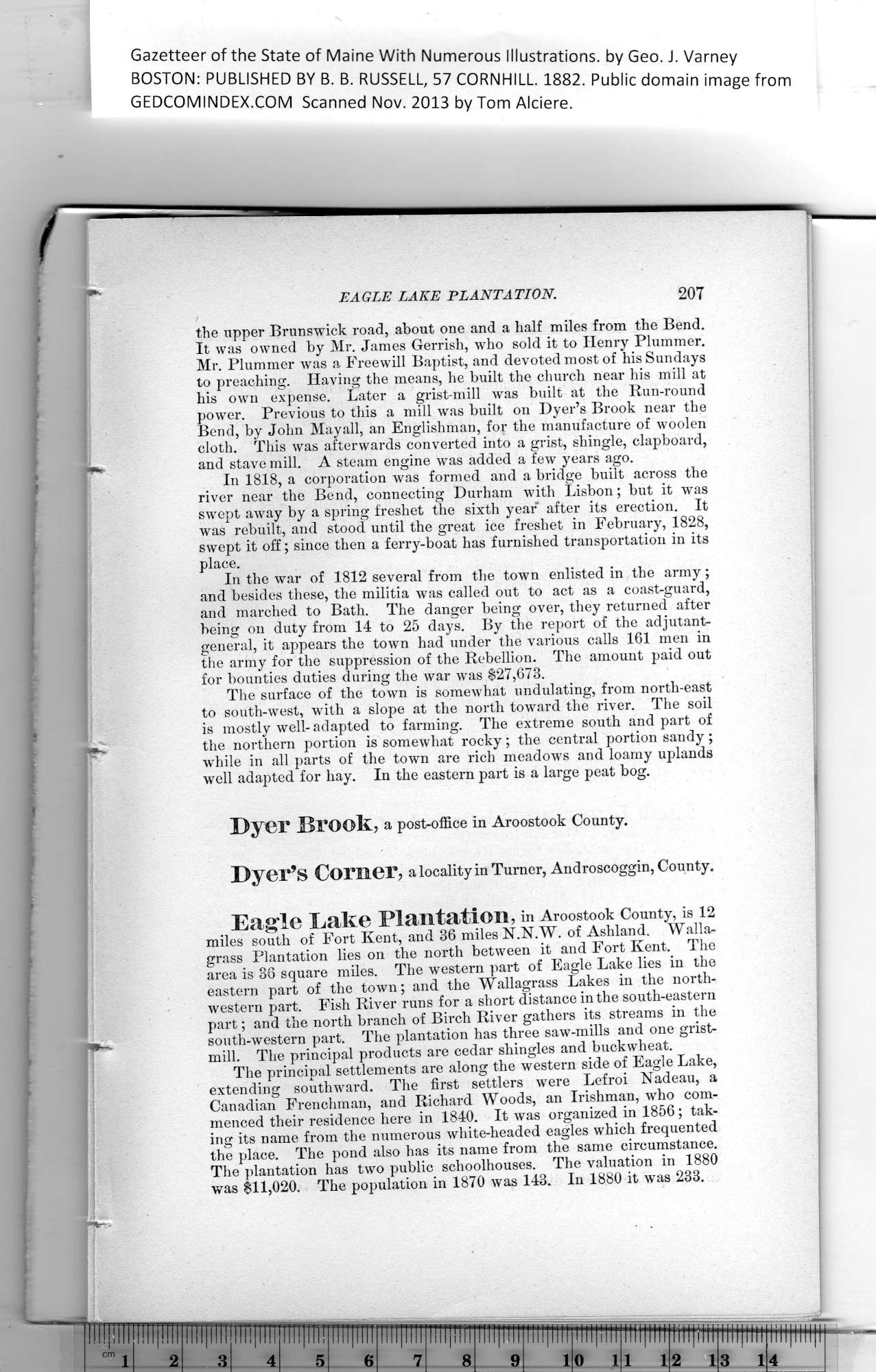|
Gazetteer of the State of Maine With Numerous Illustrations, by Geo. J. Varney
BOSTON: PUBLISHED BY B. B. RUSSELL, 57 CORNHILL 1882. Public domain image from
EAGLE LAKE PLANTATION. 207
the upper Brunswick road, about one and a half miles from the Bend.
It was owned by Mr. James Gerrish, who sold it to Henry Plummer.
Mr. Plummer was a Freewill Baptist, and devoted most of his Sundays
to preaching. Having the means, he built the church near his mill at
his own expense. Later a grist-mill was built at the Run-round
power. Previous to this a mill was built on Dyer’s Brook near the
Bend, by John Mayall, an Englishman, for the manufacture of woolen
cloth. This was afterwards converted into a grist, shingle, clapboard,
and stave mill. A steam engine was added a few years ago.
In 1818, a corporation was formed and a bridge built across the
river near the Bend, connecting Durham with Lisbon; but it was
swept away by a spring freshet the sixth year after its erection. It
was rebuilt, and stood until the great ice freshet in February, 1828,
swept it off; since then a ferry-boat has furnished transportation in its
place.
In the war of 1812 several from the town enlisted in the army;
and besides these, the militia was called out to act as a coast-guard,
and marched to Bath. The danger being over, they returned after
being on duty from 14 to 25 days. By the report of the adjutant-
general, it appears the town had under the various calls 161 men in
the army for the suppression of the Rebellion. The amount paid out
for bounties duties during the war was $27,673.
The surface of the town is somewhat undulating, from north-east
to south-west, with a slope at the north toward the river. The soil
is mostly well-adapted to farming. The extreme south and part of
the northern portion is somewhat rocky; the central portion sandy;
wTiile in all parts of the town are rich meadows and loamy uplands
well adapted for hay. In the eastern part is a large peat bog.
Dyer Brook, a post-office in Aroostook County.
Dyer’s Corner, a locality in Turner, Androscoggin, County.
Eagle Lake Plantation, in Aroostook County, is 12
miles south of Fort Kent, and 36 miles N.N.W. of Ashland. Walla-
grass Plantation lies on the north between it and Fort Kent.^ The
area is 36 square miles. The western part of Eagle Lake lies in the
eastern part of the town; and the Wallagrass Lakes in the north-
western part. Fish River runs for a short distance in the south-eastern
part; and the north branch of Birch River gathers its streams in the
south-western part. The plantation has three saw-mills and one grist-
mill. The principal products are cedar shingles and buckwheat.
The principal settlements are along the western side of Eagle Lake,
extending southward. The first settlers were Lefroi Nadeau, a
Canadian Frenchman, and Richard Woods, an Irishman, who com-
menced their residence here in 1840. It was organized in 1856; tak-
ing its name from the numerous white-headed eagles which frequented
the place. The pond also has its name from the same circumstance.
The plantation has two public schoolhouses. The valuation in 1880
was $11,020. The population in 1870 was 143. In 1880 it was 233.
PREVIOUS PAGE ... NEXT PAGE
This page was written in HTML using a program written in Python 3.2
| 